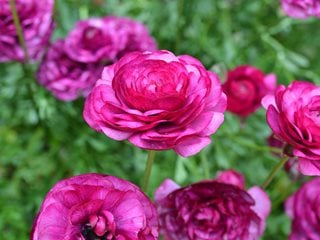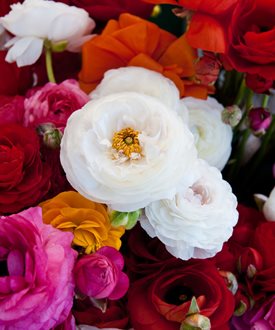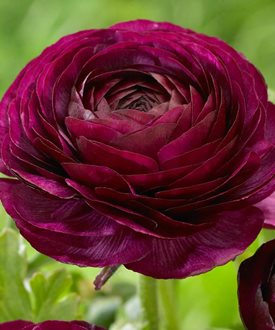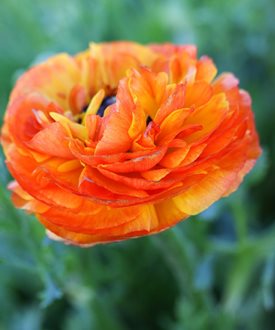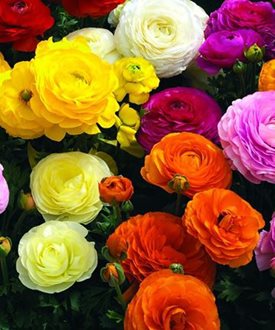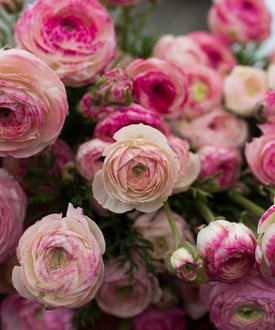How to Grow Your Own Ranunculus
A must-have addition to the spring cutting garden, ranunculus rivals the rose as the ultimate cut flower.Unless you live in a mild Southern California climate, you are more apt to see ranunculus (Persian buttercups) in a floral shop or bridal bouquet instead of growing in your neighbor’s garden. These show-stopping spring bloomers have long been a favorite of commercial florists because of their brilliantly colored flowers and long vase life. But if you’re an admirer of ranunculus and have been longing to grow your own, it’s easier than you might think. Although ranunculus is a frost-tender tuber, it can be grown as an annual in most climates, and the bulbs are inexpensive and widely available at many nurseries and mail-order suppliers.
“With so many wonderful qualities — tall stems, double-ruffled blooms, a light citrusy rose fragrance, high productivity, and one of the widest color ranges imaginable — it is impossible not to fall head over heels for these beauties,” says grower and floral designer Erin Benzakein, author of Floret Farm's Cut Flower Garden: Grow, Harvest & Arrange Stunning Seasonal Blooms.
On this page: Ranunculus Basics | Buying Tips | Planting Guide | Pictures | Ideas for Using Ranunculus
RANUNCULUS BASICS
Botanical name:
Ranunculus asiaticus. The name is derived from the Latin word rana, or frog, because of the plant’s preference for wet growing conditions.
Common name:
Persian buttercup
Zones:
Hardy in zones 8 to 11. Can be successfully grown as an annual in cooler climates (zone 7 and below).
Bloom time:
Early spring to summer, depending on the climate.
Cultivars:
Two strains of R. asiaticus are commonly cultivated for planting in home gardens. Both have cup-shaped flowers that look like a hybrid of a peony and a tea rose, with abundant layers of papery petals set off by feathery parsley-like leaves.
- ‘Giant Tecolote’ produces large double-flowered blooms up to 6 inches wide on stems as tall as 2 feet. It comes in almost every color except blue, and some of the most exotic varieties have green centers, variegated petals, and picotee edges.
- The less common ‘Bloomingdale’ hybrid is a dwarf variety that produces the same lush petal-packed blooms but on shorter, sturdier stems 8 to 10 inches high.
BUYING TIPS
When to buy:
The clawlike bulbs, or tubers, of ranunculus are widely available in fall at nurseries in mild-winter climates and in fall and early spring from mail-order suppliers. You can also find them at big-box retailers such as Amazon, Home Depot, and Walmart. Some nurseries also sell ranunculus in pots in the spring, which is a good option if want to grow them in containers.
Larger bulbs produce more flowers:
Always buy the largest tuber size available (called jumbos) because they will be more prolific and the flowers will be larger, says Benzakein. Bigger tubers will produce 10 to 12 stems in a growing season and as many as 35 flowers. Although smaller bulbs won’t flower as well, they may be acceptable for containers and mass plantings.
Buy in quantity:
Generally, you’ll get a better bargain if you buy the bulbs in larger quantities. They are often sold in packages of 25 for less than 50 cents a bulb. Ranunculus seeds are even less expensive and sold year-round, but they usually must be started indoors.
Read the label:
Occasionally you’ll see ranunculus bulbs sold generically by color with no identification as to the cultivar, such as mixed ranunculus, white ranunculus, or yellow ranunculus. The plant height and flower size given on the label will give you a clue as to what strain you are buying.
PLANTING GUIDE
When to plant:
ln areas where temperatures don’t drop below 10° F, such as on the West Coast and in the South, ranunculus can be planted outdoors in fall with minimal protection. In colder areas where temperatures dip well below freezing for extended periods, wait to plant the tubers in late winter or early spring (once you’re sure the ground won't freeze) or start them indoors in pots about 12 weeks before the average last frost date. Once the plants emerge, they can tolerate light frost. Ranunculus normally starts to flower about 90 days after planting. “Fall planted tubers bloom in early spring and continue steadily for six to seven weeks. Late-winter-planted tubers will flower by midspring and continue for four to six weeks,” says Benzakein.
Where to plant:
Like most tubers, ranunculus can adapt to a wide range of growing conditions as long as you give them full sun, sufficient moisture, and soil with good drainage. The one environment they can’t tolerate is warm and overly wet, which can lead to rotting, says the National Gardening Association.
Planting from tubers:
Plant ranunculus tubers with the “claws” pointing downward, spacing them about 6 to 8 inches apart. Cover them with about an inch of soil and water thoroughly. After giving them a good soaking, don’t water them again until you see some green showing. If planting ranunculus in containers, the NGA recommends using one or two jumbo-size tubers for each 10-inch pot.
Planting from seed:
Sow ranunculus seeds indoors in late winter in a lightweight, peat-based seed-starting mix. The key is to allow them to germinate in a cool environment at temperatures of 50° to 60° F. Once the seedlings begin to emerge, keep them moist and out of direct sunlight until you move them outdoors. Ranunculus sown from seed will typically flower 3 to 4 months after planting.
Water and fertilizer needs:
Once your plants begin growing, water them adequately but don’t allow the soil to become soggy. If you are growing ranunculus as an annual, fertilization isn’t necessary.
After they bloom:
Like other spring-blooming flowers, ranunculus thrive in cool temperatures but will begin withering when the heat of summer arrives and the soil warms up. Because the bulbs are inexpensive, gardeners in most climates treat ranunculus as annuals, composting them after they bloom and the foliage dies back. If you’re willing to put in the effort, you can save the tubers for replanting the following spring by digging them up, cutting off the dead foliage, and storing them in a cool, dry place.
For more on how to plant bulbs:
PICTURES
IDEAS FOR USING RANUNCULUS
In the garden:
Even though ranunculus bulbs are most commonly sold in mixed colors, purchasing a single color will give you the versatility to create your own striking color combinations. Because ranunculus are cool-season spring bloomers, intermingle them with other vibrant cool-season annuals and perennials such as snapdragons, violas, Virginia bluebells, oriental poppies, late-flowering daffodils, and peonies. For more ideas, see All-Star Spring Flowers for Your Garden.
In floral arrangements:
Like most tubers, ranunculus can adapt to a wide range of growing conditions as long as you give them full sun, sufficient moisture, and soil with good drainage. The one environment they can’t tolerate is warm and overly wet, which can lead to rotting, says the NGA.
- Cut stems when the buds are colored and squishy like a marshmallow, but not yet fully open, recommends Benzakein. If the blooms are open when you take cuttings, they will still last a week but will be more fragile. When your cut flowers start to droop and the stems begin to bend, cut the stems short and cluster them in a smaller vase so you can make your cuttings last a few more days.
- Ranunculus in a spring mix does the job that a rose or peony might do later in the season. “The ranunculus is the perfect alternative to a real rose. I often use ranunculus in spring floristry and am surprised at how frequently I'm asked which rose they are,” says flower artisan Georgie Newberry, author of Grow Your Own Wedding Flowers.
- Pure white ranunculus (such as white Tecolote) is especially popular in spring bridal bouquets. It blends in with any color scheme, but also looks lovely alone or mixed with other white flowers like jasmine or lily-of-the-valley.
- The delicate, hollow stems of ranunculus are prone to rot, so be sure to keep the water level in the vase low, advise Alethea Harampolis and Jill Rizzo, authors of The Flower Recipe Book. One of their favorite “recipes” for displaying ranunculus is very simply, in a round ceramic vase with the leaves removed from the stems to create a clustered bouquet. Or arrange them in vintage fruit cans with colorful labels that will complement the flowers’ cheery colors
RELATED:
Top 20 Spring-Blooming Bulbs
24 Cutting Garden Flowers
More Popular Bulbs
Flowers to Grow for Garden Bouquets
